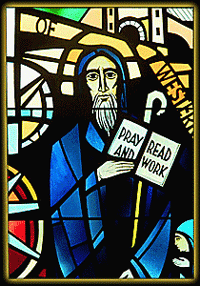St. Benedict
Feast Day: July 11
Benedict of Nursia gave Western monasticism its form. Born in Italy in around 480 AD, Benedict studied in Rome, but found life there too distracting. So he went to Subiaco and lived in a cave. Daily, he prayed—alone except for God.
Soon, word spread about Benedict’s holiness. Monks from a nearby monastery asked him to be their abbot, or leader. But they found his ways too strict. So Benedict returned to his cave and prayed.
Then more men came. Benedict formed them into 12 small groups of 13 monks each. But as the years passed and Benedict spent more time in prayer, he began to envision a larger group of monks, living in community, finding Christ in one another.
So Benedict founded the monastery of Monte Cassino in around 529. It became the wellspring of Western monasticism. He wrote a rule, or way of life, for the monks there. Benedict established a rule of poverty, chastity, obedience, and stability. (Stability means that the monks made a vow to stay at Monte Cassino.)
In his rule, Benedict asked his monks to work the fields and follow Jesus by serving the people who lived nearby. Benedict set up eight times each day for the monks to meet together for prayer. This prayer would hold them in community. By praying the Psalms, the monks would praise and worship God.
Having lived a life of prayer and work, Benedict died about 547. The monks buried him next to his twin sister, Scholastica, at Monte Cassino.
Connecting to Faith First® Legacy Edition
Grade 2, chapter 26
Grade 4, chapter 24
Grade 6, chapter 8
Junior High, Church and Sacraments, chapter 5
Connecting to Faith First®
Grade 6, chapter 8
Junior High, Creed and Prayer, chapter 22
Junior High, Liturgy and Morality, chapter 22


